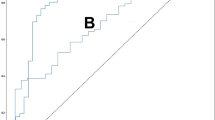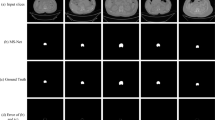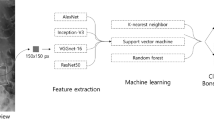Abstract
The measurement of bone mineral density for osteoporosis has always been the focus of researchers because it plays an important role in bone disease diagnosis. However, because of X-ray image noise and the large difference between the bone shapes of patients under the condition of low contrast, existing osteoporosis diagnosis algorithms are difficult to obtain satisfactory results. This paper presents an improved osteoporosis diagnosis algorithm based on U-NET network. Firstly, the bone in the original image are marked and used to construct the data set. And then, by normalizing the input of each layer, it can be ensured that the input data distribution of each layer is stable, so that the purpose of accelerated training can be achieved. Finally, the energy function is calculated by combining the value of the softmax prediction class for each pixel on the final feature map with the Cross entropy loss function and all the segmented images are extracted to obtain the diagnostic result. As the experimental results show that the improved U-net can accurately solve the influence of image interference in the process of bone mineral density measurement. The recognition rate of U-net automatic diagnosis method is above 81%, and the diagnosis effect is better than other comparison methods.




Similar content being viewed by others
Explore related subjects
Discover the latest articles and news from researchers in related subjects, suggested using machine learning.References
Peng, Q., Yi, J., Deng, Z. et al., Cluster prototypes and fuzzy memberships jointly leveraged cross-domain maximum entropy clustering. IEEE Transactions on Cybernetics 46(1):181–193, 2016.
Qian, P., Jiang, Y., Wang, S., Kuan-Hao, S., Wang, J., Hu, L., Muzic, R. F., and Jr., Affinity and penalty jointly constrained spectral clustering with all-compatibility, flexibility, and robustness. IEEE Transactions on Neural Networks and Learning Systems 28(5):1123–1138, 2017.
Qian, P., Zhao, K., Jiang, Y., Kuan-Hao, S., Deng, Z., Wang, S., and Muzic, Jr., R. F., Knowledge-leveraged transfer fuzzy c-means for texture image segmentation with self-adaptive cluster prototype matching. Knowledge-Based Systems 130:33–50, 2017.
Qian, P., Zhou, J., Jiang, Y., Liang, F., Zhao, K., Wang, S., Kuan-Hao, S., and Muzic, Jr., R. F., Multi-view maximum entropy clustering by jointly leveraging inter-view collaborations and intra-view-weighted attributes. IEEE Access 6:28594–28610, 2018.
Jiang, Y., Wu, D., Deng, Z., Qian, P., Wang, J., Wang, G., Chung, F.-L., Choi, K.-S., and Wang, S., Seizure Classification from EEG Signals using Transfer Learning, Semi-Supervised Learning and TSK Fuzzy System. IEEE Trans. Neural Systems & Rehabilitation Engineering 25(12):2270–2284, 2017.
Jiang, Y., Deng, Z., Chung, F.-L., Wang, G., Qian, P., Choi, K.-S., and Wang, S., Recognition of epileptic EEG signals using a novel multi-view TSK fuzzy system. IEEE Trans. Fuzzy Systems 25(1):3–20, 2017.
Jiang, Y., Chung, F.-L., Wang, S., Deng, Z., Wang, J., and Qian, P., Collaborative fuzzy clustering from multiple weighted views. IEEE Transactions on Cybernetics 45(4):688–701, 2015.
Jiang, Y., Chung, F.-L., Ishibuchi, H. et al., Multitask TSK fuzzy system modeling by mining intertask common hidden structure. IEEE Transactions on Cybernetics 45(3):548–561, 2015.
Xia, K., Yin, H., Qian, P., Jiang, Y., and Wang, S., Liver semantic segmentation algorithm based on improved deep adversarial networks in combination of weighted loss function on abdominal CT images. IEEE Access 7:96349–96358, 2019.
Xia, K., Yin, H., and Zhang, Y.-D., Deep Semantic Segmentation of Kidney and Space-Occupying Lesion Area Based on SCNN and ResNet Models Combined with SIFT-Flow Algorithm. J. Medical Systems 43(1):2:1–2:12, 2019.
Lorenc, R., Głuszko, P., Franek, E., Jabłoński, M., Jaworski, M., Kalinka-Warzocha, E., Karczmarewicz, E., Kostka, T., Księzopolska-Orłowska, K., Marcinowska-Suchowierska, E., Misiorowski, W., and Więcek, A., Guidelines for the diagnosis and management of osteoporosis in Poland : Update 2017[J]. Endokrynologia Polska 68(5):604–614, 2017.
Mcclung, M., Baron, R., and Bouxsein, M., An update on osteoporosis pathogenesis, diagnosis, and treatment[J]. Bone 98:37, 2017.
Grover, M., and Bachrach, L. K., Osteoporosis in children with chronic illnesses: Diagnosis, monitoring, and treatment[J]. Current Osteoporosis Reports 23(08):98–107, 2017.
Zeytinoglu, M., Jain, R. K., Vokes, T. J., Vertebral fracture assessment: Enhancing the diagnosis, prevention, and treatment of osteoporosis[J]. Bone, S8756328217300728 (2017).
Nasser, Y., Hassouni, M. E., Brahim, A., et al. Diagnosis of osteoporosis disease from bone X-ray images with stacked sparse autoencoder and SVM classifier[C]// international conference on advanced Technologies for Signal & image processing. IEEE, 19–24, (2017).
Chou, S. H., and Leboff, M. S., Vertebral imaging in the diagnosis of osteoporosis: A Clinician’s perspective[J]. Current Osteoporosis Reports 12(2):108–117, 2017.
Nakamoto, T., Taguchi, A., Verdonschot, R. G. et al., Improvement of region of interest extraction and scanning method of computer-aided diagnosis system for osteoporosis using panoramic radiographs[J]. Oral Radiology 24(22):2108–2117, 2018.
Abid, A., Pereira, D., Fernandes, J. C. et al., Sensitivity study of ultrasonic guided waves to cortical bone mechanical properties with axial and circumferential propagation[J]. Acta Acustica united with Acustica 103(3):421–429, 2017.
Malochet-Guinamand, S., Pereira, B., Tatar, Z. et al., Prevalence and risk factors of low bone mineral density in spondyloarthritis and prevalence of vertebral fractures[J]. BMC Musculoskeletal Disorders 18(1):357–369, 2017.
Radominski, S. C., Bernardo, W., Paula, A. P. de, et al. Brazilian guidelines for the diagnosis and treatment of postmenopausal osteoporosis[J]. Revista Brasileira de Reumatologia (English Edition), S2255502117300470, (2017).
Salehi-Abari, I., Early diagnosis of osteopenia/osteoporosis by bone mineral density test using DXA method in early adulthood-a pre-emptive step towards future bone health[J]. International Journal of Rheumatic Diseases 20(1):122–125, 2017.
Oka, R., Ohira, M., Suzuki, S. et al., Fracture risk assessment tool (FRAX) and for the diagnosis of osteoporosis in Japanese middle-aged and elderly women: Chiba bone survey[J]. Endocrine Journal 65(2):193–202, 2017.
Suo, Q., Xue, H., Gao, J., et al. Risk factor analysis based on deep learning models[C]. ACM International Conference on Bioinformatics, Computational Biology, and Health Informatics, 394–403, (2016).
Kulkarni, K. R., Gaonkar, A., Vijayarajan, V. et al., Analysis of lower back pain disorder using deep learning[J]. IOP Conference Series Materials Science and Engineering 12(1):263–277, 2017.
Qian, P., Chen, Y., Kuo, J.-W., Zhang, Y.-D., Jiang, Y. et al. mDixon-Based synthetic CT generation for PET attenuation correction on abdomen and pelvis jointly using transfer fuzzy clustering and active learning-based classification. IEEE Transactions on Medical Imaging. https://doi.org/10.1109/TMI.2019.2935916.
Ordóñez, C., Matías, J. M., de Cos Juez, J. F. et al., Machine learning techniques applied to the determination of osteoporosis incidence in post-menopausal women[J]. Mathematical and Computer Modelling 50(5–6):673–679, 2009.
Pedoia, V., Majumdar, S., and Link, T. M., Segmentation of joint and musculoskeletal tissue in the study of arthritis[J]. Magnetic Resonance Materials in Physics, Biology and Medicine 29(2):207–221, 2016.
Keun, Y. T., Kean, K. S., Won, K. D. et al., Osteoporosis risk prediction for bone mineral density assessment of postmenopausal women using machine learning[J]. Yonsei Medical Journal 54(6):1321–1332, 2013.
Kim, S. K., Yoo, T. K., Oh, E., et al. Osteoporosis risk prediction using machine learning and conventional methods.[C]// Engineering in Medicine & Biology Society. IEEE, 12–18 (2013).
Author information
Authors and Affiliations
Corresponding author
Ethics declarations
All the authors are aware of it in this study.
Conflict of interest
We declare that we have no conflict of interest.
Human and animal studies
This article does not contain any studies with human participants or animals.
Additional information
Publisher’s Note
Springer Nature remains neutral with regard to jurisdictional claims in published maps and institutional affiliations.
This article is part of the Topical Collection on Patient Facing Systems
Rights and permissions
About this article
Cite this article
Liu, J., Wang, J., Ruan, W. et al. Diagnostic and Gradation Model of Osteoporosis Based on Improved Deep U-Net Network. J Med Syst 44, 15 (2020). https://doi.org/10.1007/s10916-019-1502-3
Received:
Accepted:
Published:
DOI: https://doi.org/10.1007/s10916-019-1502-3




